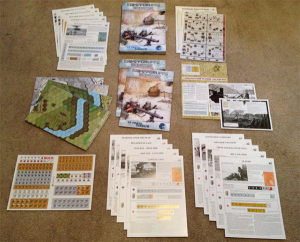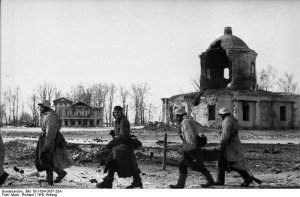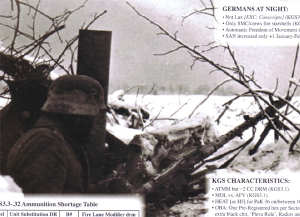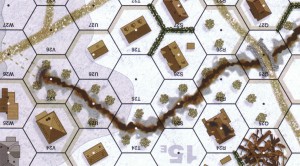Bruce Geryk needs no introduction to readers of Flash of Steel or listeners of Three Moves Ahead. He is my friend, my combatant and one of the people I can count on for totally honest feedback on pretty much anything. Also, one of my favorite wargame writers. His guest post is about a game you never heard of that may define 2011 for him.
Everyone remembers years for different reasons. For gamers, there is usually a game attached. I know 1990 was the year I graduated from college, but it was most definitely also The Year of Civilization. I’m not quite sure what happened in 1994, but I sure can tell you it was The Year of X-COM. For me medical school started in 1998, but it could have otherwise been The Year of about a million different great games. Maybe it was just The Year.
Remembering years with games sometimes seems like a luxury of times when there wasn’t much more to worry about than what to play next. At one time, going to the game store was all about which one thing could I afford to buy that month with my paper route money. Maybe there were more game stores, too, or just stores that carried games. Heck, Toys R Us carried board wargames once upon a time. Sometimes I wish I could go back and just remember what that was like.
A few months ago, basically I did. A local game store here called The Gamer’s Armory carries a selection of games that I would have had a hard time imagining in the good old days when a large retail toy chain had Avalon Hill wargames on the shelf. I finally made the 20-minute drive there after working for 30 hours, and when I walked in, I thought maybe I was in a sleep deprivation delirium. Separate displays held games about the ancients, American Revolution, Napoleonics, American Civil War, World War I, World War II, and the modern era, all by chronological category. The Advanced Squad Leader section takes up three full wall displays. Want any Schwerpunkt scenario pack? They have it. Want an ASL magazine, like MMP’s ASL Journal, or the outstanding French publication Le Franc Tireur? It’s there. Want an official module or expansion pack? Pick it up and take it to the counter.
The game I ended up taking to the counter is called Kampfgruppe Scherer: Shield of Cholm — a dramatic name for an esoteric and superficially mundane product: a historical module for ASL about the encirclement and siege of Cholm, Russia, during the winter and spring of 1942. It wasn’t a physically large product on the shelf, but it did cost $105. And when I brought it home, it was worth it just to open it up and read the designer’s justification for why he would make a game about an obscure Eastern Front topic in the first place.
“…gliders were having to land in the streets under heavy fire…”
It was this line, encountered while I was searching for another “special operation” to depict for ASL, that landed me in Cholm.
That intro says everything there is to say about why wargamers get hooked on whatever they’re obsessed with at the moment. As designer Andrew Hershey describes it, he was reading about German glider development in a book about World War II German aircraft, saw this reference to glider operations in the battle for Cholm, and all of a sudden that was his next project. He even made a pun out of it.
It’s a great story, and I’m sure you love it. But I wouldn’t write a whole article about an ASL module without an interesting hook. Ok, I totally would. But Troy wouldn’t publish it. (ed: Hell, no.
In 1977, The Year of Squad Leader, I remember the designer’s notes saying that the first scenario, entitled Guards Counterattack, on which the objective building was a few hexes across and which took place on half a mapboard, was meant to abstract the Dzerzhinsky Tractor Works because depicting the actual factory would require seven full Squad Leader mapboards! I was just a kid when I read that, and I laughed because it seemed totally crazy. Seven SL mapboards! What was more impossible than that? The Soviet Union collapsing because of democracy? No, I meant what I said: SEVEN SL MAPBOARDS!
Age has a way of giving you perspective, and it also has a way of making you live long enough to see crazy things. In 1989, The Year of SimCity, I saw two more crazy things: the sudden and complete dissolution of a hideous social experiment known as Communism, and an Advanced Squad Leader module that depicted a factory in Stalingrad on the equivalent of seven ASL mapboards. You can imagine which one I found more unbelievable.
Squad Leader was designed at a time when designers naively believed that more detail in a game meant more realism. I’ve spent a lot of my writing career trying to debunk this. But who cares, right? Everybody knows that detailed wargames suck now. It’s all about streamlined systems, functional abstraction, and playability. But just like everyone has room in his or her inventory for a +1 longsword, everyone loves himself some detail in a wargame. Detail isn’t a goal in itself, but instead creates a sense of depth which makes the world more real. That’s what all those fuel points meant in Campaign for North Africa. If you had to keep track of gas in the trucks, then it made all the sand in all those empty desert hexes more permanent and relevant.
But that detail builds a world — a world that is more meaningful when persistent. Combat Mission, one of my favorite games of ever and ever amen, can’t get this right. I’m not sure why. A few years ago, Battlefront was working on something called Combat Mission Campaigns. It was supposed to make individual CM battles meaningful. I’m not sure how they were going to do it. I don’t know if Battlefront does, either, since the project got canceled. But everyone understands the general idea: if you fight one battle, how you do it makes a difference in the next.
HASL (Historical Advanced Squad Leader) was all about this. The regular game had plenty of context, but was missing consequence. Sure, I took that stone building with my last half-squad. The scenario is over. But what if I have to hold it now, with my depleted order of battle?
Modules like Red Barricades and Kampfgruppe Peiper gave you a piece of history, but they were only a piece of the battlefield. There was no way you could make an ASL map that covered all of Stalingrad, or all of the Ardennes. Reinforcements came in through a magical pipeline from somewhere, likely your counter tray. It was a break in the action, where you go back to Tristram and sell your loot because you’re out of the dungeon and monsters don’t come out and follow you there and you don’t have to worry about that.
But if you keep those units in the same dungeon, then you do. The town of Cholm, in northwest Russia, was small enough that people from the far far future could come and make hex maps out of its topography, assign numbers to its buildings, and put square cardboard counters down representing General Scherer’s battle group, and then see what happens based on some six-sided dice going into a glass cup. Ok, or a dice tower. I don’t like those but if you have a cool one then bring it on. The point is that they have nowhere to go. There is no escape.
Designer Andrew Hershey included a note in the rules booklet about it.
A note on the Kampfgruppe Scherer order of battle: since KGS was surrounded without the ability to cycle fresh troops in and out of the front lines, as in most conventional campaign games, the KGS OB is fixed at the start like a conventional scenario OB. This imparts that cauldron-like feel.
Every genre needs games to do certain things, push certain buttons, or satisfy certain cravings, or they fail. For one genre, you might call this the “frantic action feeling.”
I’ve said a million times that the most important thing you can do in a historical game is establish a sense of place. Inside that place, your game stories happen. If you don’t, you can still have a great game, but it’s so much harder.
I haven’t played Kampfgruppe Scherer yet, but I can tell you this: “cauldron-like feel” is the turn-based historical board wargame equivalent of frantic action feeling.
Andrew Hershey designed the module, but he got significant help from two people. The first is Jason D. Mark, familiar to me (and many others) for his excellent Eastern Front books, Death of the Leaping Horseman
(about the German 24th Panzer Division at Stalingrad) and Island of Fire
(about the battle for the Red Barricades factory). Mr. Mark has just released a new book, entitled Besieged: The Epic Battle for Cholm
, and he apparently shared a lot of his research with the module designer. Jason’s books are Glantz-like in their details but have a much more narrative style and tactical focus as they are essentially daily descriptions of events and include many, many historical photos, often candid shots of combatants from their own personal collections. Flipping through a Jason Mark book is like flipping through a modern heroic chronicle, like the Song of Roland with pictures, or the dwarves’ book of records in the Chamber of Mazarbul. The late, legendary SPI developer Redmond Simonsen referred to wargames as being at their best when they functioned as “paper time machines.” With their chronological and pictorial record, Jason Mark’s books are the historiographic equivalent.
The second is a guy named Dirk Burgdorf, who isn’t a gamer, or even a professional historian, but who has done more for the historical awareness of the town of Cholm than ten centuries of boyars. In the designer’s notes booklet included with Kampfgruppe Scherer, Burgdorf explains how he came to be involved with the project. Dirk is interested in history, likes to visit battlefields, and at one point was working in Moscow. As he tells the story, he had a copy of a book written by German war correspondent/photographer Richard Muck about the siege of this little town, and decided to take a trip there. I’ll quote from part of Burgdorf’s story in the historical booklet because it’s too good to leave trapped in a curiosity box.
I arranged a meeting with the local museum director in Cholm, Elizabeta Petrovna Semenova. I tried to ask a few basic questions in my pidgin Russian about the town during the wartime, and had brought a copy of Muck’s “Kampfgruppe Scherer” with me as an aid in pointing out some of the structures. I began to inquire where in town some of these had been. As I pulled out the book and pointed to the first picture, Elizabeta Petrovna froze, then reached across the table and slid the book out of my hands, and began quietly paging through it. Finally she looked at me in astonishment and asked “Otkuda u Vas eta kniga?” (“Where did you get this book?”) It had never occurred to me that, as a backwater hamlet with no functioning Internet, and with very limited means at their disposal, the town could have constructed a small museum, focused on its history and that of the surrounding rayon, and never even known about this publication. In short, there did not exist a single wartime photo of their town in their own museum.
That was it. I had been “bitten.” What started out as mild curiosity led to an obsessive need to help the town, and with that the rest of the literary world, fill in this gap in history. In short order, I returned to Cholm again, and organized a meeting of the town’s senior citizens. I brought an LCD projector and had digitalized the Muck book, so was able to project selected photos onto a screen and get consensus from those who still remembered as to where many of the pictured buildings and locations had been, and what each one was. It is hard to describe the effect it has on a group of aged people for them to see photos of a building in the beloved hometown, for which they have seen neither the building nor even a photo of it for over 50 years. A lot surfaced out of the grey matter that day, and with it came both astonishment and some tears. … Subsequent visits led to videotaped interviews with older citizens of the town who recounted with emotion and tears the horrors of being trapped in a town under siege. For some of them, it was the first time they had spoken in detail about it. One old woman sobbed like a baby as she recounted to me about having to flee a burning house during the siege with her brother, mother, and grandmother, as fighting raged in the town. Racing across the street, their grandmother trailed the rest, and was cut down by machine gun fire. They turned to go back and help her, but she lay in the street screaming for them not to risk it, and to just keep moving. The gunfire was too intense to try, and the old woman got her wish. They never saw her again.
Like I said, Burgdorf isn’t a gamer. But in part through his efforts, we have a beautiful historical ASL module that preserves a piece of history that was very nearly lost, and which simultaneously creates that sense of place that is so elusive that I can count on two hands the number of games I’ve played which really did it right. Reading through Dirk’s portion of the module’s historical booklet is unlike anything I’ve ever read in a wargame, because it illuminates a historical event in a place from the perspective of people living there now. And Dirk Burgdorf doesn’t even play ASL.
I spend more time than I care to addressing the idea that wargames are somehow immoral, or insensitive, or gratuitously violent. Sometimes, when I have the time and patience, I try to explain that maybe an interest in historical gaming can lead to a better understanding of history, and therefore of people. It never occurred to me that you could approach the problem from the opposite direction, and through an understanding of people, make a contribution to the preservation of history, and thus somehow to gaming.
For me, 2011 just became The Year of Kampfgruppe Scherer.






Fantastic essay; I’ve saved it for further reading!
I remember when my local mall toy store – in Albuquerque, no less – had SPI wargames as well as Avalon Hill wargames!
There was even a dedicated Albuquerque gaming store – Wargames West – where one could meet other wargaming aficionados, in real life. And later, in Berkeley, CA, I’d go to a gaming store (near Shattuck Ave., iirc) whose name I forget (help me out guys) where I’d play Squad Leader in the store.
At each place, I met people whose general interest in history went far beyond wargames and military history.
All of those places that I knew are gone now, they were on their last legs when I knew them, but it’s good to know that a few still exist.
I wish Bruce wrote more. I LOVE stuff like this.
When I read posts like this, it makes me want to become a deeper wargamer. Now that I have The Russian Campaign on my shelf and (fingers crossed) a copy of ASLSK #1 coming for Christmas, I’m on my way.
More, Bruce! More.
I can only second Geoffrey’s comment.
But I wouldn’t write a whole article about an ASL module without an interesting hook. Ok, I totally would. But Troy wouldn’t publish it. (ed: Hell, no.)
Troy’s loss. And as evidence that it is a loss, I submit the above post.
I’ll also mention that The Year is 1997 for me. At least in computer gaming. :)
Bruce Geyerk writing about war games is like getting to taste a fine congac…best savored and enjoyed slowly with several friends of a like mind.
Would love to hear Dirk Burgdorf and/or Andrew Hershey in a podcast talk about this scenario. Why make a ASL scenario for over $100? Were they expecting some sort of significant monetary return?
Also have to mention the “Spare Time Hobby Shop” in Westborough, MA whose owner hobnobbed with Charles Roberts, the founder of the Avalon Hill Gaming Company.
Thanks everybody. Geoffrey, I wish I wrote more, too. But then I also wish I didn’t work 100 hours every week.
JonathanStrange, I still have a mail-order receipt from Wargames West for my copy of Avalon Hill’s Anzio, purchased in 1982. Cost = $12. They were one of my go-to sources for wargames I couldn’t get locally: huge selection and reasonable shipping. I used to call them on the phone (long distance charges!) and “browse” their selection.
Rindis and KVolk, you can get more of these posts if you bug Troy to send me a setup for our email game of PQ-17.
skshrews, the $100 price is perfectly reasonable. That’s probably the price at which their expected sales will cover their costs with some profit. If you think you’re going to sell 200 copies (completely invented number) and charge $100 each, that probably covers your costs and gives you a some leeway. If you charged $25 and doubled or tripled your sales, you’d still come up short in comparison. The market for ASL products is extremely inelastic. My guess is that people are either going to buy it, or not. For King and Country, the replacement module for West of Alamein with the British OOB reprint, costs $75. The market is now priced for middle-aged guys who are mid- to end-career with disposable income to spend on their hobby. It’s not for impulse-buy kids in the hobby store anymore. $100 is less than what I or someone else might spend on dinner for two people.
For comparison, MMP is taking pre-orders for Festung Budapest. The pre-order price is $97.50, and the “retail” price is $130. They already have over a thousand pre-orders.
Also, it’s not really just a “scenario.” If you look at the photo at the top, it’s a product with very high production values, with separate rules and designer’s notes booklets, a countersheet, play aids, separate maps for winter and spring (great touch), overlays, and multiple scenarios. It’s basically a game. At $105, it is completely in line with the specialty boardgame market these days. For a boutique product from a boutique shop, you pay a premium.
I mean, I just paid fifty bucks to the same guys for several countersheets of turret counters. Absolutely no joke. Check it out:
http://www.lefranctireur.org/spip.php?rubrique18
Bravo Mr Geryk.
As a non wargamer, I always assumed that deep historical knowledge came before the game, both for the designers and the players.
Articles like this are fascinating because they provide an entry point to learning and discussing history… brushing up against it — touching it, if you will. :) I opened up about 7 tabs on wikipedia while reading this post.
Great essay!
Nice write up, Bruce. I don’t like ASL myself (although I did buy SL when it was released, and all the original expansions, and probably played SL as much as any other boardgame), but I think it’s cool that stuff like this is made for people who do like it.
I wanted to post to say just how awesome The Gamer’s Armory looks! There are a couple of decent game stores here (central Ohio), but they are the sort of stores where wargames are sort of an afterthought. The Gamer’s Armory looks a little like a wonderful store that used to exist in Dayton, Ohio called The Tin Soldier. It was just a classy place that had games displayed on individual shelves. This was the early ’80s, the heyday of board wargames, and even then I wasn’t sure how a place that nice stayed in business selling only consims.
I envy your 20 minute drive to such a place.
Nice read, Bruce, and it’s good to see you still manage to save a slice of free time now and again to write for the hobby.
I’ve made a mental note to check out the Gamer’s Armory when the flying machine takes me to that part of the country. Thanks for the link.
When are we going to see a sitrep on the PQ-17 game? Did it ever materialize? Both too busy in the salt mines, or is there some heel dragging going on in the Goodfellow camp? I’ve still got that game on my “maybe” list.
I will send my Vassal PQ-17 set up when I get back from out East.
Jonathan:
Games of Berkeley?
(I spent more than a few pennies there during 10 years at Cal).
Bruce –
Your writing is a joy! Do you have a bibliography or your pieces? I’ve read you over at Quarter to Three and followed it here.
Thank you once again.
Steve
As a long-time board wargamer (Tobruk! Waterloo!), this reminded me of a lot of my youth. The saddest thing is that as great as computer games have been in a lot of ways for the hobby, nobody has ever quite reproduced the experience of some of those games. Someday I hope to see that computer version of Ambush!